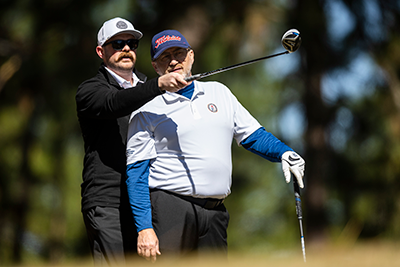
By Brian Murphy
Bob Banks, a lifelong golfer and softball player, started to lose his vision in his mid-50s.
In a matter of weeks, something called Leber’s hereditary optic neuropathy (LHON), an inherited optic nerve disease, robbed him of his central vision. Banks was distraught.
Among his many emotional reactions, he tossed his golf clubs in the trash. What use is a blind golfer? Good question, actually.
Go ahead and ask the dozens of blind or visually impaired golfers who gathered at Haggin Oaks in Sacramento from October 25-26 for the 76th National Championship Blind Golf tournament. The tournament is run by the U.S. Blind Golf Association, which has been around since 1953. Their slogan says it all: “You don’t have to see it, to tee it!”
Banks realized all this when he was down and out and researching what life would be like living with LHON. He saw a YouTube video of a blind man playing golf. Hold on. He could still play golf?
“It was like a cartoon bubble over my head: Errrrrrrrr, wait!” Banks says. “I said to myself: I better go get my clubs out of the trash before the garbageman comes!”
There are degrees of blind golf. A “B1” golfer has no sight. A “B2” golfer has limited usable vision. A “B3” golfer has better usable vision. All players have their sight classification certified by a doctor. Amazingly, there is golf without sight. It’s quite a powerful thing, too, once you research it.
The stories of blind golf are the stories of friends helping friends. Each player has a “coach,” a person who helps the blind golfer get set up, get their yardage, talks them through their shot and guides them to the next shot. The coach sets the blind golfer up on the putting green, too – and a modification to the Rules of Golf allows “no penalty if a player’s coach positions himself on or close to an extension of the line of play or the line of putt behind the ball during a stroke, provided the coach does not assist the player in any other manner during the stroke.” But the technical help is a small aspect of the relationship. As Banks will tell you, and as multiple blind golfers attest, the bond formed between the blind player and his or her coach makes blind golf a team sport like no other.
For Banks, it was his sister, Cindy Anderson, who first convinced him that he could do it. She rushed in and took her brother to driving ranges right away, set his swing up, and researched all aspects of blind golf. Right away, Banks felt a rush returning to the game he thought he’d lost. “I started striking it cleaner, because I had no expectations and just kept my head down,” he says. “I felt like a 12-year-old boy again, I honestly did.”
Another friend, Banks’ neighbor in the East Bay, Jerry Shaman, had recently retired and volunteered to help. Shaman and Banks play four times a month. Banks takes pride in not slowing anyone down. Sometimes he needs directions to be pointed to the flag. People are nice. They help. An electronic “golf buddy” on Banks’ hat gives him yardage. He can see the flag once he gets to about 20 yards out, and his head covers have enlarged numbers on all clubs so he can tell a 5-iron from a 7-iron. He plays to about a 15 Handicap Index, he estimates and finished third at nationals last year. Shaman was his coach at Haggin Oaks.
That it’s the 76th Blind Golf National Championship speaks to the competitive spirit of blind golfers. The Godfather of the sport was a Minnesotan named Clint Russell who was featured in “Ripley’s Believe It or Not!” in 1932 for shooting 84 totally blind. He won the first national in 1946. The runner-up was a man named Charlie Boswell, who lost his sight in combat in World War II.
Seventy-six years later, the blind golf spirit continues. Banks says the meeting is a gathering of old friends first, golfers second. “Nobody complains about their condition,” he says. “Everyone is too busy hugging and laughing.”